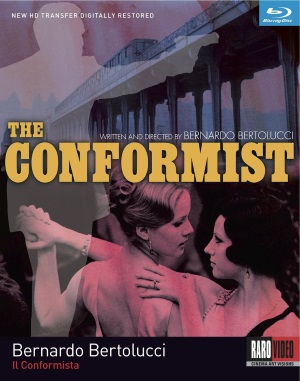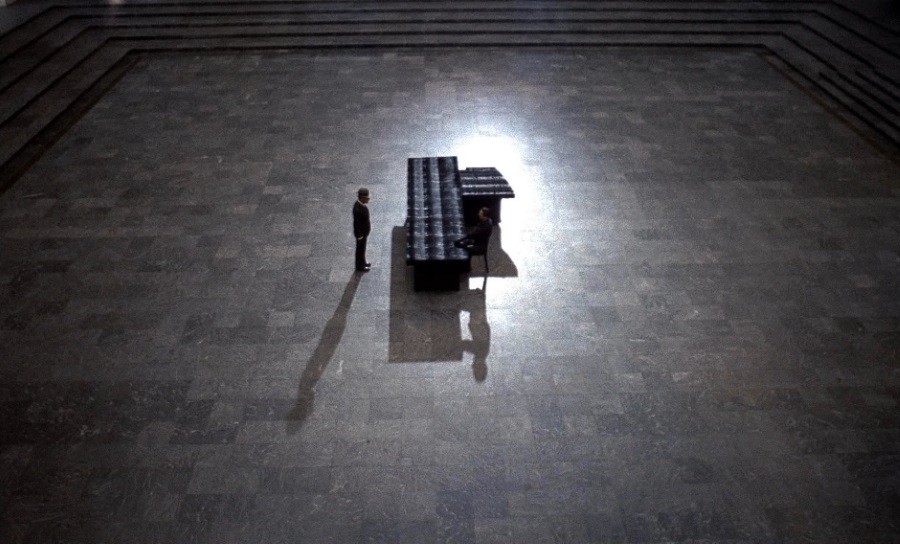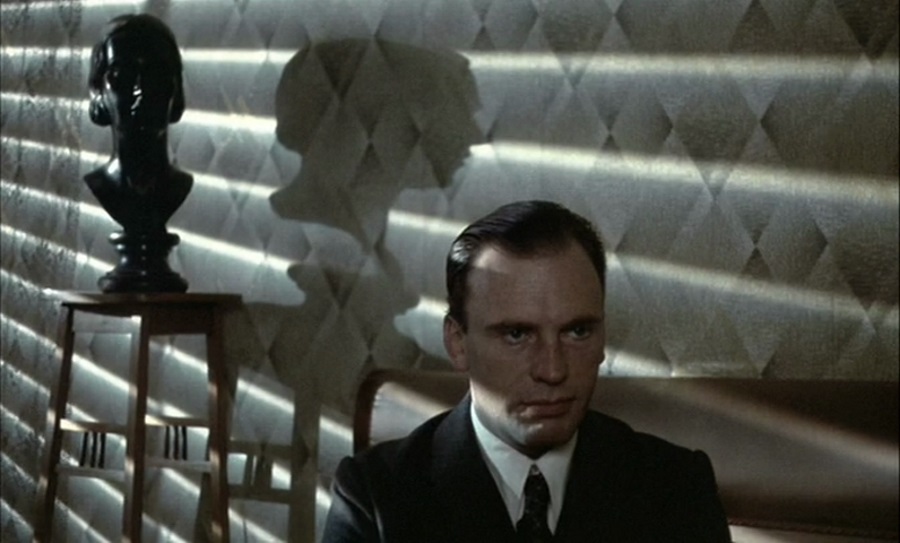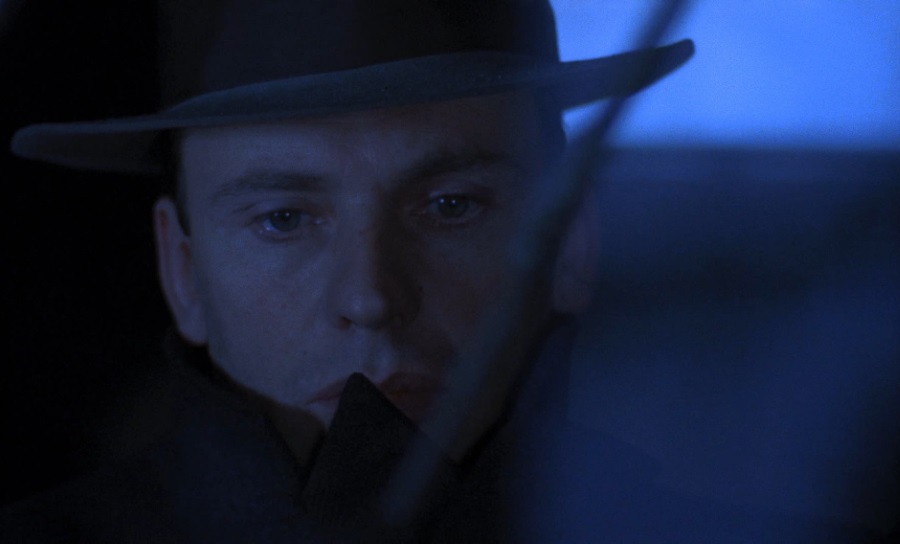 The Conformist (Raro, Blu-ray, DVD) opens in the deep blue of dawn, an intense, vibrant azure with a hint of ultramarine that blankets the city like an ocean. Marcello Clerici (Jean-Louis Trintignant), a petty bourgeois Italian who just wants to disappear into the fabric of his society, specifically Mussolini’s Italy in the 1930s, has volunteered to be an informant for the Secret Police. He doesn’t believe in the Fascism, he just wants to belong, and under the glow of this overwhelming blue he heads off oversee the political assassination he has been called to facilitate. This is the temperature of his dispassionate nature, the calm of conformity that he desires, but even under this comforting ocean of reassurance, he remains anxious and out of place, a pretender to this society who wears his convictions like a suit. It’s all about appearance.
The Conformist (Raro, Blu-ray, DVD) opens in the deep blue of dawn, an intense, vibrant azure with a hint of ultramarine that blankets the city like an ocean. Marcello Clerici (Jean-Louis Trintignant), a petty bourgeois Italian who just wants to disappear into the fabric of his society, specifically Mussolini’s Italy in the 1930s, has volunteered to be an informant for the Secret Police. He doesn’t believe in the Fascism, he just wants to belong, and under the glow of this overwhelming blue he heads off oversee the political assassination he has been called to facilitate. This is the temperature of his dispassionate nature, the calm of conformity that he desires, but even under this comforting ocean of reassurance, he remains anxious and out of place, a pretender to this society who wears his convictions like a suit. It’s all about appearance.
I focus on this blue because until now, it has never enveloped me so as I watched Bernardo Bertolucci’s The Conformist (1970). I’ve seen the film on 16mm college prints, on 35mm revival prints, and on Paramount’s DVD from a decade ago, but this restoration brings out Vittorio Storaro’s colors with a richness and a depth I’ve never seen before. For the first time those hues have reached through the screen and into my experience.
Color is central to the experience of The Conformist, pushed to intensities beyond what we could call natural yet nothing so actively artificial as the great MGM Technicolor musicals or as symbolically loaded as Antonioni’s Red Desert. It’s not some much unreal as hyper-real, a subjective reality as seen through the eyes of Marcello, a man seeking comfort in conformism and compromise. Those blue filters create a deep blue ocean of a sky, a perpetual twilight that is at once calming and unsettling. If it represents Marcello’s ideal state of stasis, it threatens to drown him as much as comfort him, and its chilly atmosphere suggests his amoral compromise. He may desire Anna (Dominique Sanda), the young wife of his former professor, but it sure isn’t love, and he’s quick to shut off any human connection to her when his mission as an agent / informer for the Secret Police comes to fruition. He has no love for his own beautiful, shallow, and silly petite bourgeois wife Guilia (Stefania Sandrelli), who is “all bed and kitchen,” he tells his best friend, a blind radio personality who spouts Fascist propaganda on a daily basis. Marcello only has self-loathing. His father is in an asylum and his mother, once rich and now broke but living a decadent lifestyle in a crumbling manor, disgusts him. And then there is that childhood trauma that he thinks this act will expiate. It’s all very symbolically loaded, a flashback to a world of sepia-tinged nostalgia that is tangled up in sexual confusion, guilt, and innocence besmirched, a psychological motivation that ultimately explains nothing beyond the excuses he gives himself.

It’s a superb performance by Trintignant, whose presence is the film is physically passive even as he tries to play the confident, intellectual leader of men. He is stiff and still and pulls himself inward, instinctively resistant to physical contact. (He is also dubbed into Italian, as is Dominique Sanda.) In the memorable scene at a cheery dance hall, a room of bright lights in the midst of the blue sea of Paris at evening, Anna dances with a very willing, drunk, and giggly Giulia in a Paris bar, and then swirls the line of dancers around Marcello, who is caught in the middle of the empty dance floor and suddenly surrounded, the center of attention. His arms go up defensively, to keep the world from making contact. That passivity, his complete lack of conviction, is what fools his old professor (Enzo Tarascio), an anti-Fascist now in exile in Paris that he has been assigned to gather information on, into believing he can sway the former student to his side.
The Conformist was hugely influential on American cinema of the seventies. Coppola picked up the stylized color palettes for The Godfather movies, where the sepia became an idealized past contrasted with the chilly present of Michael’s corruption, and brought Storaro over to shoot Apocalypse Now, while Paul Schrader reached out to production designer Ferdinando Scarfiotti to be his “visual consultant” on American Gigolo and Cat People, films with defining, carefully painted color palettes. Bertolucci, Storaro, and Scarfiotti showed them that it was possible to marry such expressionism with the strain of seventies realism in American cinema. Not that anyone would mistake anything in The Conformist as realism. It is heightened, exaggerated, distorted, the world reimagined by the filmmakers as something familiar yet not. It is magnificent.
The original American release was cut by about five minutes. It was restored to its full version in 1994 and released on a fine DVD edition by Paramount a decade ago. This disc is mastered from a new restoration commissioned by the Cineteca di Bologna in 2011 and mastered from the original negative in 2K for digital screenings and for disc. It brings out the rich hues while preserving the texture of the film. It looks like a film print from 1970, not a piece of digital photography. Raro’s release on Blu-ray and DVD features the “visual essay” In the Shade of the Conformist with Italian film critic and historian Adriano Apra and featuring clips from a 2011 video interview with Bertolucci, plus two trailers and a 28-page booklet with essays and excerpts from archival reviews, articles, and interviews. The credits on the booklet also helpfully identify the actors who dubbed Trintignant and Sanda.
Calendar of upcoming releases on Blu-ray, DVD, Digital, and VOD


